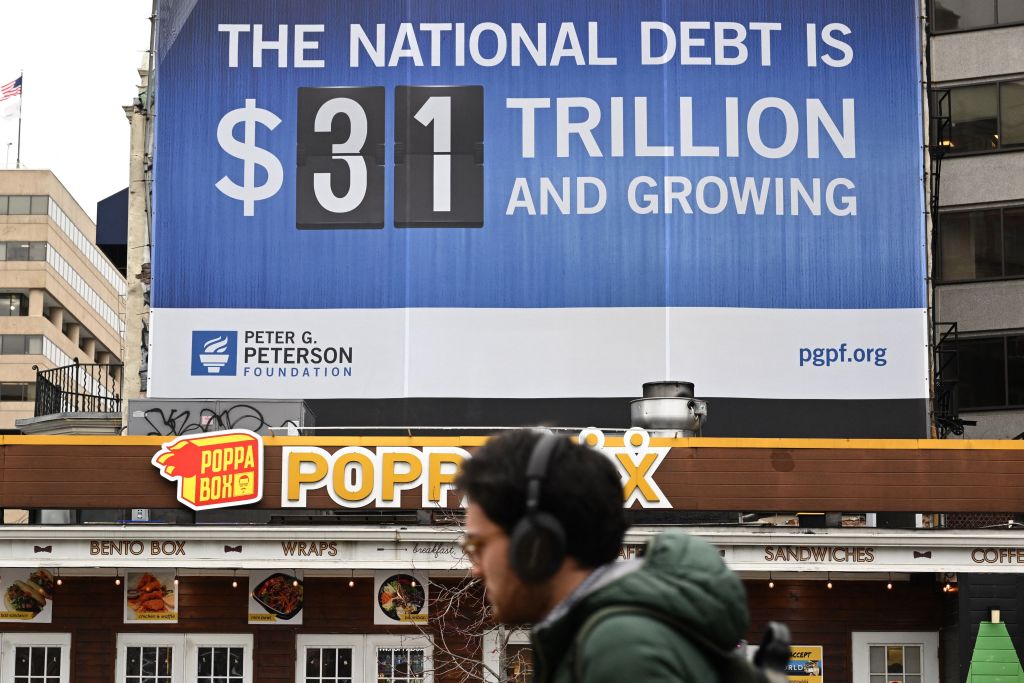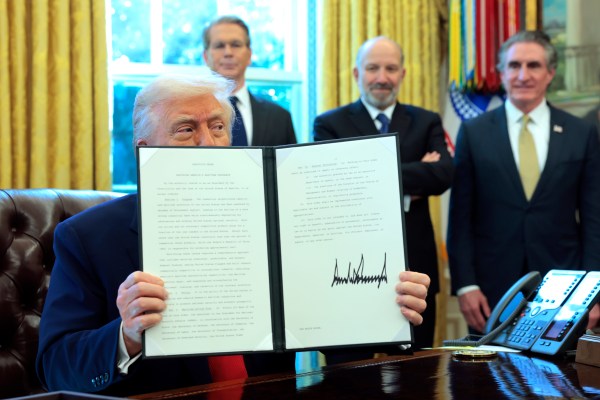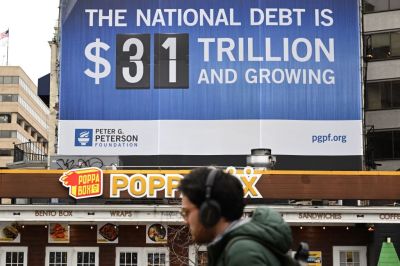The political clash over the debt ceiling has resulted in Republicans sounding like fiscal conservatives again: House Speaker Kevin McCarthy said this week that America’s national debt is the “greatest threat” to the country’s future.
How exactly does debt threaten the country, and how might it realistically be addressed?
Putting $31 trillion in context.
Throughout downtown Washington, D.C., billboards and posters from the Peter G. Peterson Foundation remind passersby that the national debt is now $31.4 trillion—and rising. Of that $31.4 trillion, about $25 trillion is held by the public. The rest consists of money the government owes itself—the Social Security Trust Fund often loans surplus income to the Treasury Department, for example.
While the topline number has legal implications—the debt ceiling most pressing among them—the $25 trillion in public debt is the more economically meaningful number, said Marc Goldwein, a senior vice president at the Committee for a Responsible Federal Budget.
To put that in context, $25 trillion “is about a full year’s worth of all production in the economy” measured in gross domestic product (GDP), he said. It hasn’t always been this way. The last time public debt exceeded annual GDP was immediately after World War II.
“We’ve never had a situation in our whole history where debt was as large as the economy and was on course to be growing indefinitely,” Goldwein said. “We are in uncharted waters.”
How does the debt hurt the economy?
Debt can be quite useful strategically.
“If the return on an investment you are making is higher than the interest you are paying to borrow the money to make that investment, then it’s a reasonable thing to do,” said Ben Ritz, director of the Center for Funding America’s Future at the center-left Progressive Policy Institute.
And those returns aren’t always easy to measure in dollars and cents. The U.S. used debt to fund the war effort and win World War II, for example. Other potentially high-payoff public investments include education, infrastructure, and scientific research.
But as debt continues to rise, the Treasury is obligated to commit a greater and greater share of taxpayer dollars to pay for current consumption—including entitlement programs like Social Security and Medicare—and for interest on its loans. That limits the government’s ability to make good investments for the future.
Interest payments are on track to become the biggest government “program” in the next few decades, according to a Peterson Foundation analysis of recent Congressional Budget Office projections. That means the U.S. would spend more maintaining its debt than it does on defense spending by 2029, Medicare by 2046, and Social Security by 2049.
Public debt also can crowd out private investment. “When the government issues bonds, people buy those bonds at the expense of investing in stocks or at the expense of investing in corporate bonds,” Goldwein explained. “When we issue bonds, we reduce the amount of investment in the private sector in businesses and corporations and entrepreneurship and homes, and that slows our growth.”
It’s possible that the rising debt-to-GDP ratio remains a long-term drag on the economy indefinitely—a “tax on future generations,” as Bipartisan Policy Center Senior Vice President Bill Hoagland put it—without ever tipping the U.S. into a full-blown crisis.
But “the higher we go, the greater the probability is that we get there,” Ritz said. “And it’s one of those problems where if you get to the point where you can see exactly where the problem was, it’s probably too late to fix it.”
What might a debt crisis look like? “The annual deficit is persistently high, and that is leading to persistent inflation, which leads the Federal Reserve to raise rates, which raises the borrowing costs and the annual interest payments, which leads to an even greater annual deficit, which leads to more inflation, which leads to even higher rates, and you just kind of get this spiral,” Ritz said. In a worst-case scenario—which, Ritz emphasized, is only a remote possibility—that spiral could lead investors to lose confidence in U.S. Treasury securities and rush to sell older, lower-yield bonds in a panic that could irreparably damage the United States’ standing in the global financial system.
Goldwein gave an extreme example to illustrate this point. If everyone was holding 10-year bonds that pay 2 percent yield, and “all of a sudden you’re getting the same exact 10-year bond for an 8 percent yield, people are gonna want to sell off those 2 percent yield bonds.” And because U.S. Treasury securities are the backbone of the global financial system, that sudden selloff could cause a crisis: “High debt—maybe with other issues combined with it, political or otherwise—leads to a panic, leads to a selloff, leads to bank failures and insurance company failures and financial crisis.”
Reform is still a long way off.
Economists have long debated how much debt is too much, which in part depends on other economic factors such as interest rates and GDP. But there is clear consensus that the United States’ ballooning debt will exacerbate the drag on economic growth and the risk of an acute crisis unless Congress undertakes serious reforms.
Some groundwork has already been laid: Thirteen years ago, President Barack Obama created the Simpson-Bowles Commission to address fiscal sustainability. Goldwein, who worked for the commission, thinks something resembling the framework of its final proposal—which included spending cuts, tax increases, and entitlement program reforms such as gradually raising the retirement age—could still work reasonably well today.
But Republicans are loath to raise taxes, and Democrats are opposed to spending cuts. Both parties generally want to avoid being perceived as tampering with entitlement benefits. (The trust funds for Medicare and Social Security are projected to become insolvent in 2028 and 2035, respectively.) Last week, White House spokesman Andrew Bates dismissed calls for Congress to establish commissions to study potential future changes to the federal government’s major trust funds, an idea that has garnered some bipartisan support.
“The American people want more jobs and lower costs, not a death panel for Medicare and Social Security,” Bates told Bloomberg Government.
Given the political climate, Ritz is skeptical Congress can settle on a policy trajectory that is both politically palatable and fiscally sustainable. “In the current era, they seem to be mutually exclusive,” he said. “The longer it goes on, the more mutually exclusive they become.”





Please note that we at The Dispatch hold ourselves, our work, and our commenters to a higher standard than other places on the internet. We welcome comments that foster genuine debate or discussion—including comments critical of us or our work—but responses that include ad hominem attacks on fellow Dispatch members or are intended to stoke fear and anger may be moderated.
With your membership, you only have the ability to comment on The Morning Dispatch articles. Consider upgrading to join the conversation everywhere.